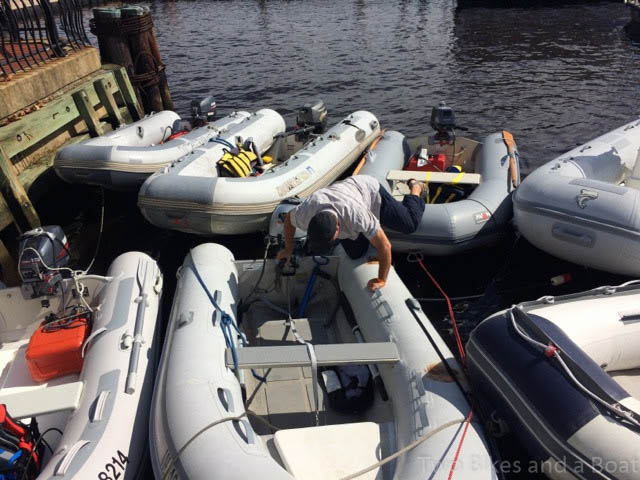As Matthew pointed out in his July post A Different Family Car, a dinghy is an important link to the shore and to other boats. We will use it for shopping, social calls and sightseeing ashore. Much as you use your family car on land, the dinghy has a very similar function when out cruising. And, just like home, reliability is really important as this might be your only way to get back to the big boat. So to protect it, our dinghy really should have some chaps. Dinghy Chaps, you say? What the heck are those ? They are a fabric cover to protect the inflatable tubes from harmful UV rays and chafe from lines and docks. OK, well I do love a good sewing project, so I offered to make them. But I really had no idea what I was taking on! In fact, I am beginning to wonder if it actually even qualifies as a sewing project, since I am three days into it, and haven’t taken the sewing machine out of its case yet.
Kinship is in the yard at Zahniser’s Marina for a bottom paint job and a pre-departure checkup and I am slaving away in a heat wave, on my biggest project ever. I decided it needs to be recorded here for posterity (and to remind myself never to try this again 🙂
Day 1 Patterning: It took me about 5 hours to make and fit the pattern. I used sheets of clear plastic, laid it over the dinghy in sections, then marked where the seams, hems, and cut-outs should go. This was hard work, on hands and knees, crawling about inside and out of the dinghy, on a hot patio. But I was glad for all the space, and the ability to have the dinghy up on dry land while working on it. This would have been twice as hard to do on board.

Day 2 Cutting: I needed to lay out 8 metres of light grey sunbrella fabric, so I needed a big flat clean surface.The marina let me use their upstairs balcony with a canopy over it. I just had to move a few patio tables and chairs and voila! Instant cutting board. Again, on my hands and knees, using the hot-knife to cut the fabric so the edges would not fray, I spent 4 or 5 hours on this hot, smelly job. Fortunately my patterning was good, so very few adjustments were required when I fit the pieces back on the dinghy.

Day 3 Making the vinyl anti-chafing patches: This was the biggest part of the job yet! 8 full hours measuring, marking, cutting out, fitting, starting over…but at least I could work in the comfort of the air-conditioned laundry room, on a good size table. I had 19 cut-outs to do, and was almost done when I ran out of masking tape (essential for holding the patches in place once they are cut and fitted), and my kitchen scissors had gone so dull from cutting the vinyl that they needed to be replaced in order to cut the remaining patches. A trip to the hardware store is required.

Day 4 more patches: 2 more hours of cutting and fitting patches. I must be getting tired, because the starboard side needed more fitting than the port side had. I had to take a break from the project for the boat launching, but tomorrow I will finally get to start sewing, in my cockpit sewing-room! Can’t wait!
Day 5 Sewing (finally): Like with house-painting, the longest part is the prep work. In 5 hours I had 90% of the patches sewn into place. I started out working in my cockpit, but soon found that the wind and weather, along with the bulkiness of the fabric made it much more difficult to work aboard, so I went back to the laundry room. Fortunately most people using the room for its intended purpose were curious enough about what I was doing not to object too much at my apparent hostile take-over of the facility!

Day 6: Sewing and fitting: Once the patches were all on, I sewed the pieces together and conducted the final fitting. Only one small adjustment to the first two patches I had done, and all was well. After a total of 30 hours, I really felt like I had something to show for my efforts.

The project is not finished yet. I estimate another 10 hours or so to finish it – add a rub-rail, a few more anti-chafe patches, hems, casings and snaps to hold the whole thing onto the boat – but for now it’s put away. Time to get out on the water. Kinship passed her pre-departure check-up, and we are heading for Portsmouth VA to meet up with the Rally next week!













